Opinion: Tom weighs the pros & cons of the new-age old question, should I suppress my bedside home defense weapon?
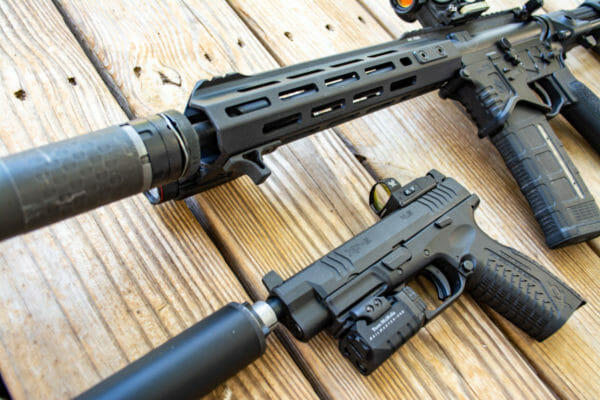
USA – -(AmmoLand.com)- Just a year or two ago things were looking up for suppressors. With the Hearing Protection Act written and in the legislative works, a semi-friendly House of Representatives and Senate, and the White House seemingly friendly towards signing a bill, things seemed positive for getting suppressors out of NFA jail. No more tax stamps, photos, fingerprints, body probes, and year-long waits just to make your gun run quieter.
Then, politicians did the politician dance, meaning they didn’t do a damn thing except fundraise and stump for reelection. Now, the House has flipped and there’s a better chance that Alyssa Milano will become the new NRA President than the Hearing Protection Act passing before Wolf Blitzer takes an anchor job with the Blaze.
Even still, you can buy one, just like before, as long as you’re prepared to wait. So, today’s question is, with all that headache and waiting around just to get your hands on a suppressor, should you ever consider using one on a home defense firearm? As with anything else, there are pros and cons to consider. Here’s a list of things to ponder.
Suppress a Home-Defense Gun Sound
Since “looking cool” isn’t really considered a useful feature for a home-defense rifle or pistol, the big benefit to using a suppressor is the sound reduction. Duh. If you’ve not touched off a round indoors before, hold on to your shorts. It’s loud. If you use an AR, the indoor noise level is orders of magnitude beyond loud. Deafening comes to mind.
So, do you or should you care? While living through the encounter will rank far higher to me than protecting some percentage of my hearing when I’m 78, I’m not so much worried about long-term hearing impacts as the “here and now” benefits. While a suppressed pistol or rifle shot indoors will still be loud (remember, Hollywood suppressor whisper noises aren’t real) you’ll stand a much better chance of being able to hear important things like family members, 911 operators on the phone, and sirens or shouts from responding officers during or after suppressed gunfire. It is something to think about…
Size
I’ve been testing a Springfield Armory SAINT Edge pistol, and it’s sitting next to my nightstand outfitted with a SilencerCo Saker 556 suppressor. It’s a handy combination because given the smaller size of the pistol the addition of a suppressor still keeps the total package length shorter than that of a standard AR-15 rifle. With the stock set where I like it, the SAINT Edge with suppressor measures about 32 ½ inches overall. A Rock River Arms 6.8 SPC AR-15 I keep handy measures 37 inches unsuppressed. So, if you go pistol or SBR for the firearm, and suppress that, you can still come in with a package that’s shorter overall than the loud version of a rifle.
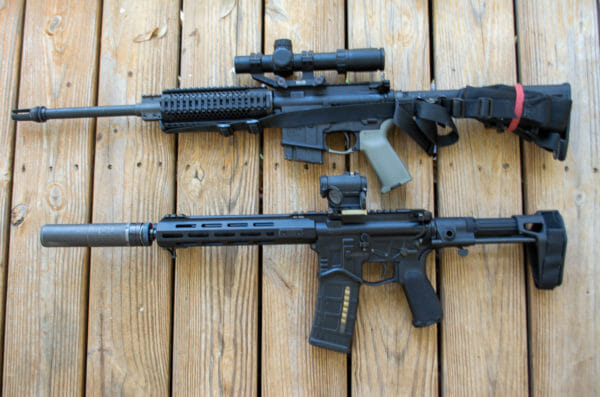
To get more specific, the way this particular Saker 556 silencer mounts, it adds a net length of 4 ½ inches to the length of whatever firearm you stick it on. The suppressor is 6 ¾ inches long overall, but some of that covers the muzzle device on the rifle, hence the shorter net length impact. Just as a comparison, the same SAINT Edge pistol without the suppressor measures just 28 inches the way, I have it configured.
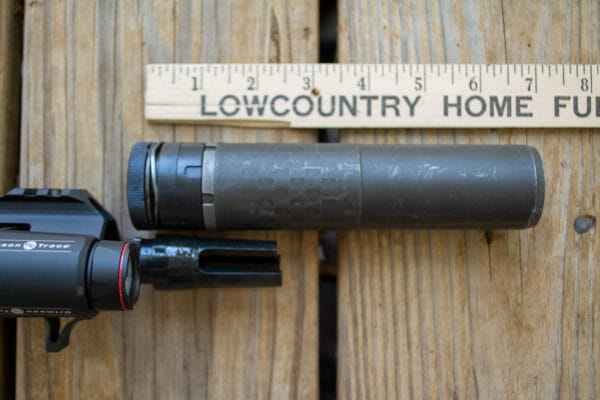
As for pistols, you don’t get as much benefit in terms of overall length impact since much less of the can goes over the muzzle. The Springfield Armory XDM OSP Threaded Model pistol shown here measures about 8 ½ inches overall sans suppressor. When I stick an old Specwar Octane 45 suppressor (now replaced by the new Silencerco Hybrid model) on it, overall length increases to about 16 ½ inches. Still, way more compact and maneuverable than an AR rifle or pistol and you can use it one-handed, even with the silencer attached.
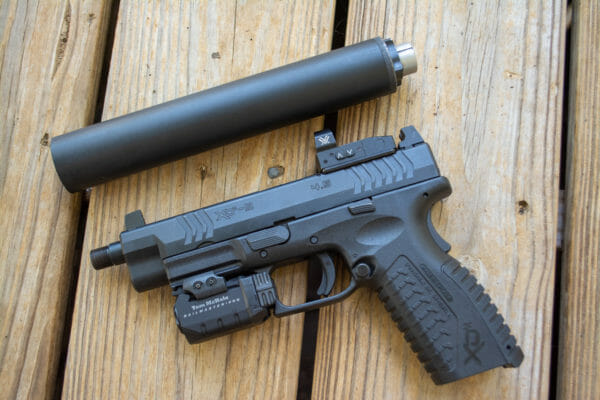
If you use a shotgun for home defense, should you suppress it, assuming you have one of those nifty SilencerCo Salvo 12 suppressors? Probably not. Don’t get me wrong, they’re cool, and lots of fun. They just make a standard shotgun about the size of a High School flagpole. Maybe if you stuck one on a new Shockwave shorty…
Home Defense Suppressor Weight
While you won’t be climbing mountains or hiking miles with a home-defense firearm, weight still matters. To me, the biggest factor is one-handed use if necessary. Of course, this is mostly a handgun issue as AR rifles, shotguns, and even AR pistols are most practically used with two hands in some form or fashion. Unless you’re starring in a Sharknado movie. Then you should be able to dual wield a couple with no adverse effects.
That Octane 45 pistol suppressor weighs a hair under 13 ounces, or just shy of a pound in round numbers. It doesn’t sound like much, but remember, all that weight is sticking way out beyond the muzzle, so handling gets a little weird. The XMD OSP pistol, configured with a Vortex Venom optic and Crimson Trace Rail Master Pro light and laser weighs 1 pound, 13 ounces, so in round numbers, the suppressor increases the handling weight by about 50 percent.
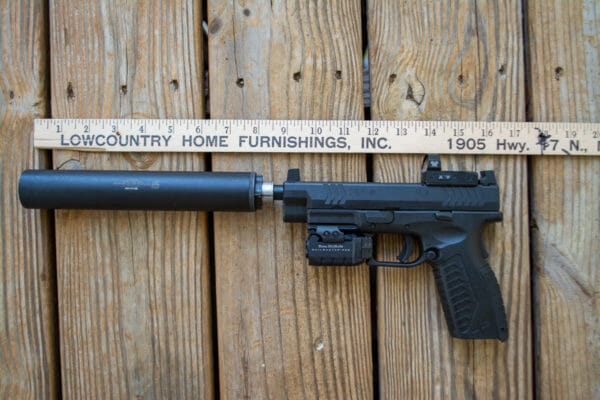
In case you were wondering, that Saker 556 suppressor for the AR weighs 1 pound, 3 ounces. Given the heavier overall weight of the AR pistol and regular two-handed use, the handling isn’t impacted nearly as much as the pistol configuration.
Evidence
Here’s the bummer. If you fire your gun in a home-defense encounter, there’s an excellent chance that you’ll make a long-term donation to the Museum of Evidence Locker. Your firearm and any suppressor attached to it will sit and rot in some police HQ closet for months or even years.
This isn’t something I lose sleep over for the same reason that I don’t use a cheap and crappy gun for home defense or carry for fear that it will be confiscated after a self-defense encounter. Yes, people do that. “Hey, I carry this $200 beater because if I’m ever in a fight for my life, and it becomes evidence, I’ll only be out $200!” Right… That’s the priority… If I survive, the last of my worries will be having to replace a firearm, no matter how expensive it was. The same thinking applies to a suppressor. If it offers enough benefit to warrant me using it and contributes to a successful outcome, I can find a way to live without it while I go on about the business of still being alive.
NFA Paperwork
One of the rules for suppressors is that you have to have your tax stamp present when using it. Be sure it’s accessible and handy, so there’s no doubt about the legality of your silencer.
Suppressor Cleaning and Reliability
Suppressors make guns filthy, especially AR’s. The increase in backpressure brings all manner of burning hot mung and crud back into the action of your firearm. If you shoot suppressed, you’ll need to clean more frequently to be sure your gun works when you expect. While this is a drawback, it’s one easily managed with a little extra happy time with Hoppe’s Number 9.
Zeroing
Suppressors change the point of impact on most pistols and rifles by a couple of inches. Be sure to re-zero your firearm with the suppressor attached, so you know where it shoots. If it’s going to be a long-term configuration, adjust the sights or optic to match the suppressed point of impact.
If you choose a suppressed pistol, figure out your primary sighting option. The odds are that a suppressor will block standard iron sights so you’ll need to install either suppressor-height sights or an optic that’s high enough to see over the can. I’ve also had good success with using a laser as the primary sighting option on a suppressed pistol. Whether the laser is a grip style or rail-mounted, most seem to clear the suppressor body with no problem.
So home defense with a suppressor attached…?
So with all this head-scratching, what did I decide to do? Suppressed or not suppressed? I wimped out and chose both. I used to keep a suppressor on my nightstand pistol, an FNX 45 Tactical, rather than letting it just sit unloved in the safe. However, given the handling drawbacks, I’ve taken it off. The biggest benefit of the pistol for home defense is the ease of handling with one hand while you do other things with the opposite hand like open or shut doors, operate a phone, or carry a light. As for the AR pistol, I’ve left the suppressor on. Given its stunning unsuppressed noise level indoors and modest impact on handling, it doesn’t come with the same level of disadvantage as a pistol. Of course, your mileage may vary.
About
Tom McHale is the author of the Practical Guides book series that guides new and experienced shooters alike in a fun, approachable, and practical way. His books are available in print and eBook format on Amazon. You can also find him on Facebook, Twitter, Instagram, and Pinterest.
